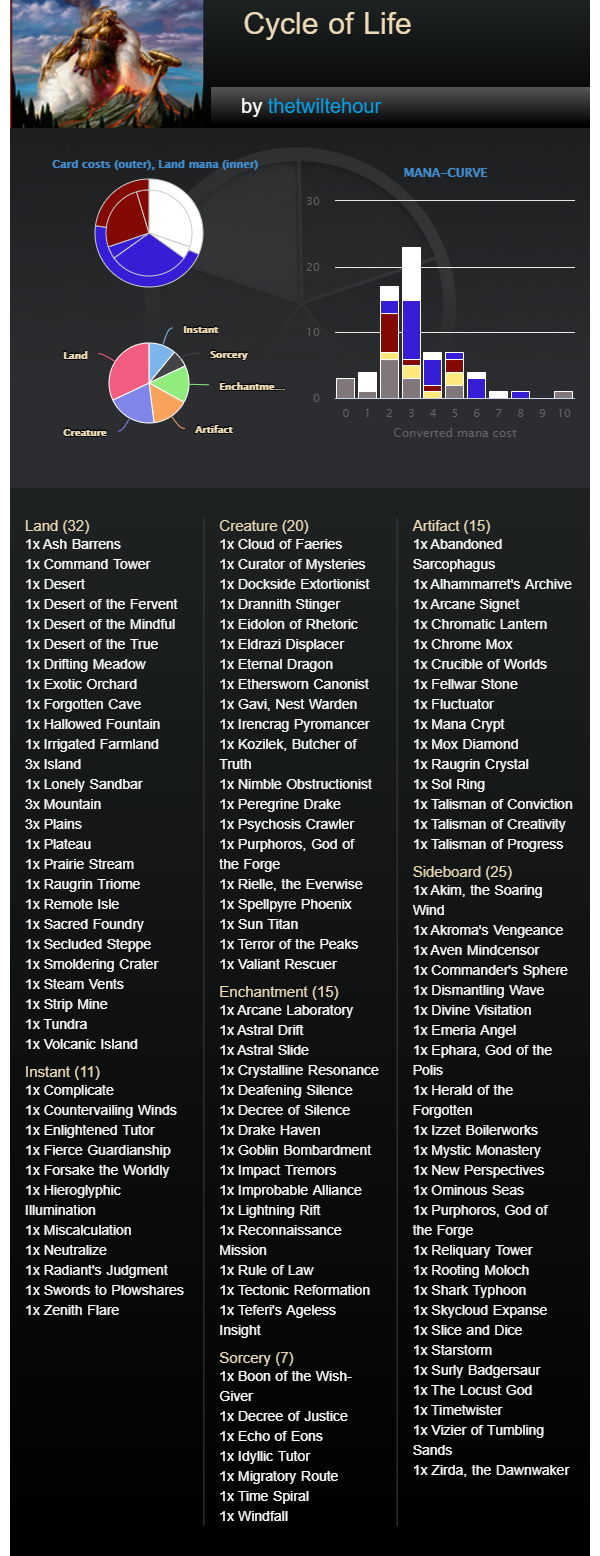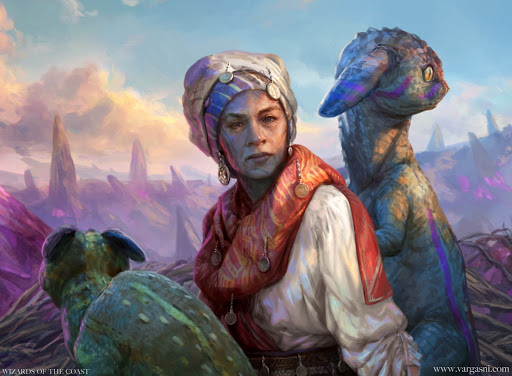Image credit: Randy Vargas, Wizards of the Coast
In Commander Focus, Pseudanonymous looks at key Commanders, how to build around them, and what makes their decks work. In this first installment, he’s looking at Gavi, Nest Warden.
Gavi, Nest Warden is a tri-color commander that came out of the Ikoria cycle. As a preconstructed deck, it fell decidedly into that “immediately swap out the titular commander for its alternate for an upgrade” category but cycling repeatedly as an ability certainly has some potential powerful upsides. Jeskai, as a commander wedge, is in a strong place. It has a bevy of potentially good commanders, but none are truly top tier.
- Kykar, Wind’s Fury lends itself to a storm deck, possibly running a backup breach combo, spamming artifacts and leveraging some powerful draw effects, also comes in at a lower 4 CMC.
- Narset, Enlightened Master was at one time considered a top tier competitive deck, using her powerful triggered ability to take endless turns for free, but at 6 CMC without haste is simply probably too slow now.
- Elsha of the Infinite has a powerful endless draw especially if you can get a Sensei’s Divining Top and a cost reducer into play allowing you to either storm or go into a breach line or perhaps run bomberman.
- Shen Yun, the Silent Tempest is one of the better one-punch commanders, and the fact he looks like one punch man doesn’t hurt.
- Truth be told, perhaps the most competitive Jeskai commander is the pairing ofBrallin, Skyshark Rider and Shabraz, the Skyshark, in part because of how the end step resolves allowing a Curiosity effect turn into a lot of damage [potentially infinite] for the table.
- Kraum, Ludevic’s Opus and Ishai, Ojutai Dragonspeaker can also form a powerful beat down combination if you can Stax out the game and simply hammer on people with commander damage, punishing your opponents whenever they cast spells.
But I wanted to build a deck around a more unique mechanic, cycling. Cycling has been around for a long time, and it’s a fairly neat, balanced mechanic. Essentially it allows you to pay some cost and discard a card with cycling to draw a card. Simple enough, and cycling abilities can be leveraged, with some cards having an effect whenever you cycle and some cards triggering off cycling. Recently Wizards has gone intensely into the idea of “the second card you draw” or “for the first time each turn” type effects. This is in part to stop the parade of endless infinite combos which can often rule eternal formats. Particularly in commander, you can see a lot of cards with “Whenever:” leveraged with a cost reducer to break parity and be leveraged into a win condition.
Cycling is rather old, as mechanics go, is rather old, first appearing in Urza block, and is one of the most popular non-evergreen mechanics. Part of what is powerful about cycling is it is not casting a spell. Many times, in order to end the game players in commander, will resolve a Silence or a Veil of Summer. Once that hits the board it is difficult to stop them, since players can no longer cast spells or counter the active players’ spells. There are a few cards that remove spells from the stack or exile them, so with the veils (there’s also Autumn’s Veil for a virtually identical effect), it’s possible to stop them via spellcasting. But cycling a spell which counters a spell when it cycles is not casting a spell, and the effect countering the spell isn’t a spell, it’s an ability.
From the Comprehensive Rules:
702.28. Cycling
- 702.28a Cycling is an activated ability that functions only while the card with cycling is in a player’s hand. “Cycling [cost]” means “[Cost], Discard this card: Draw a card.”
- 702.28b Although the cycling ability can be activated only if the card is in a player’s hand, it continues to exist while the object is on the battlefield and in all other zones. Therefore objects with cycling will be affected by effects that depend on objects having one or more activated abilities.
- 702.28c Some cards with cycling have abilities that trigger when they’re cycled. “When you cycle [this card]” means “When you discard [this card] to pay an activation cost of a cycling ability.” These abilities trigger from whatever zone the card winds up in after it’s cycled.
- 702.28d Some cards have abilities that trigger whenever a player “cycles or discards” a card. These abilities trigger only once when a card is cycled.
- 702.28e Typecycling is a variant of the cycling ability. “[Type]cycling [cost]” means “[Cost], Discard this card: Search your library for a [type] card, reveal it, and put it into your hand. Then shuffle your library.” This type is usually a subtype (as in “mountaincycling”) but can be any card type, subtype, supertype, or combination thereof (as in “basic landcycling”).
- 702.28f Typecycling abilities are cycling abilities, and typecycling costs are cycling costs. Any cards that trigger when a player cycles a card will trigger when a card is discarded to pay an activation cost of a typecycling ability. Any effect that stops players from cycling cards will stop players from activating cards’ typecycling abilities. Any effect that increases or reduces a cycling cost will increase or reduce a typecycling cost. Any effect that looks for a card with cycling will find a card with typecycling.
So we’re going to find synergies between Gavi’s ability, which is to make cycling free, and cycling cards to give us control and generate cycling effects. The win condition is a tough grindy one: try to stax out the table with rule of law and ping our opponents to death. 
- Purphoros, God of the Forge and Terror of the Peaks and Impact Tremors will do damage whenever a creature enters the battlefield under our control.
- Astral Drift and Astral Slide will blink out a creature whenever we cycle a card.
- Improbable Alliance and Drake Haven will create a creature (and thus an ETB) whenever we cycle, Valiant Rescuer the first time we cycle each turn.
- Drannith Stinger and Lightning Rift simply do damage whenever we cycle.
- Cloud of Faeries, Peregrine Drake, and Dockside Extortionist are all ETB’s that generate mana, allowing us to keep cycling.
- Ironcrag Pryomancer and Psychosis Crawler will let us damage our opponents or their creatures when we draw.
- Spellpyre Phoenix, Sun Titan, and Eternal Dragon are all really high CMC spells, but if we can slow the game down long enough or generate a ton of treasure tokens or mana, putting them into play will give us a huge card advantage and allow us to replay or regain cards we’ve previously cycled.
- Crucible of Worlds lets us replay lands we’ve cycled earlier, and is particularly powerful with Tectonic Reformation, giving all lands cycle.
- We’ve included a couple of ways to reshuffle our deck because potentially this deck can just ram through its entirety with infinite mana or cost reducers and we don’t want to lose to decking ourselves. Include whatever Timetwister variant fits your budget.
- I’d love to include a Strip Mine and a Wasteland, I think the potential synergy with the aforementioned crucible of worlds is just too strong, but there simply isn’t room for that much-uncolored mana in a tri-color deck, so just Strip Mine will have to do. But if the game goes long using Strip Mine to knee cap someone’s mana base can be really powerful.
None of these in and of themselves form an infinite combo, though we’ve included a Peregrine Drake and Eldrazi Displacer, and a secret forgotten tech, the original Desert or a Strip Mine. With these 3 in play, we can generate infinite mana and infinite ETB effects.
Our control spells will be those with cycling abilities, and our ramp likewise will focus on cycling, but we’ll use the talismans rather than signets, which, while painful, can power the Eldrazi Displacer when we need it. For a stax effect to make the game long and grindy, to let our 1-, 2-, and 3-damage effects add up to 40s, Rule of Law and Deafening Silence and Ethersworn Canonist and Arcane Laboratory. In theory, this should allow us to slow the game down enough to get our 5 cmc commander out and start cycling like mad.
Our Ramp and Land base are simply the best of the mana rocks and cycling lands.
There are plenty of other ways you can build Gavi, for example, you could run all basic, and Back to Basics, Magus of the Moon, and Blood Moon. These effects can be huge. You’d give up a lot of your land cycling, though you’d get it back with Tectonic Reformation.
One of the criticisms I have of this deck is that it feels like it will have very uneven games. Sometimes it’ll ramp appropriately lock down the game with a stax effect, and grind things out. Other times it will miss the Stax or get countered or removed, and simply be too slow to keep up. To some degree, this is a function of your meta. It also lacks arguably some of the most powerful value cards in the environment, despite them being in the commander’s color identity: Rhystic Study, Mystic Remora, and Smothering Tithe. This is a deliberate choice since we’re hoping to lock the game down. Players who can only play one spell per turn may well pay their taxes rather than simply give away the card draw and treasures, and we really can’t afford the room for them all.
Cycle of Life
Next Time: Rin and Seri, Separable from my money
Have any questions or feedback? Drop us a note in the comments below or email us at contact@goonhammer.com.


